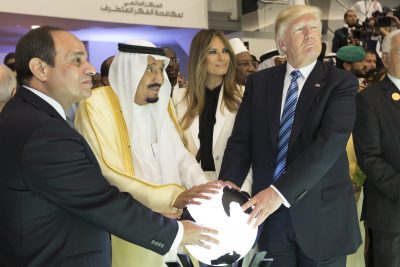“Arab NATO” Isn’t NATO-like at All

It’s become popular over the past few years to talk about the so-called “Arab NATO” that the US is reportedly trying to assemble in the Mideast to militarily contain Iran, but the actual entity being created doesn’t resemble its European predecessor at all. Rather, it appears as though the NATO branding was tacked onto it in order to simplify the purpose of this emerging alliance, not to accurately describe its intra-organizational workings or anything else related to NATO for that matter. In order to understand why everyone has it so wrong whenever they talk about the “Arab NATO”, it’s necessary to list off the main differences between these two structures.
Here’s what defines the original NATO:
- Formed after World War II;
- A directly US-led military alliance;
- Unprecedented at the time;
- A common/central operational command;
- A “captured market” for US arms.
Compare that to what the “Arab NATO” is beginning to look like:
- Forming without a regional war having taken place;
- Modelled off of the “Lead From Behind” strategy of back-end, indirect US support;
- Built upon the Gulf Cooperation Council (GCC);
- Divided between Saudi Arabia and the UAE;
- Military diversification after recent deals with Russia and China.
For all their differences, here’s what the two alliances have in common:
- Predominant American strategic influence;
- Common foes (USSR/Russia and Iran, respectively);
- Key component of larger geopolitical containment strategies;
- Based along the Eurasian Rimland;
- Multilateral military integration between regional partners.
Dual Redundancies
Unlike NATO at the moment of its inception, the “Arab NATO” is doubly redundant because two interconnected military structures already exist that preceded it. The GCC has gradually been transitioning from an economic group to a military one over the past few decades, but then Saudi Arabia unveiled its transregional Islamic Military Counter Terrorism Coalition (IMCTC) in 2015 stretching from West Africa to Southeast Asia. The latter entity is comprised of Saudi-friendly countries all across the Eastern Hemisphere’s strategically positioned “Islamic Belt”, but it has thus far appeared to be more of a symbolic creation than anything substantive. In any case, the GCC and IMCTC already exist and make one wonder what exactly it is that the US wants to achieve with the “Arab NATO”.
The Containment Core
It can’t be known for certain, but it seems like the US intends for the GCC to simply rebrand as the “Arab NATO”, whether officially or not, since the countries that are usually included in this plan are oftentimes the same ones. This suggests that the US wants to strengthen the IMCTC’s core and hopefully one day turn that larger aforementioned organization into a gigantic proxy against Iran and other Muslim targets all across the Eastern Hemisphere, though this is much easier said than done for several reasons. Here are the most basic challenges facing the US’ strategic efforts to transform the GCC into an “Arab NATO” and then expand that entity all throughout the IMCTC’s member states:
- Saudi Arabia and the UAE, the “core of the core”, are in a “friendly competition” with one another;
- “Peripheral members” of the “GCC+” like Egypt and Jordan would first have to officially join the GCC;
- Israel’s behind-the-scenes support of the “Arab NATO” is controversial without peace in Palestine;
- Some of the IMCTC’s members such as Pakistan don’t want to be “contract soldiers” for the US;
- It takes years of training, coordination, and trust-building to form an effective multinational alliance.
Being mindful of these serious challenges, it’s unlikely that the US will ever succeed in anything more than strengthening military coordination between the GCC’s members, which is already difficult enough as it is seeing as how Saudi Arabia and the UAE are basically waging two separate but semi-coordinated campaigns in Yemen. Neither of those two countries wants to enter into a position where they cede military sovereignty to the other, let alone to the US, so the very optics of an “Arab NATO” are an obstacle in and of themselves. It’s possible that they might put aside their sensitivities for symbolism’s sake, but in that case, they wouldn’t be an “Arab NATO”, but rather a strengthened GCC.
*
Note to readers: please click the share buttons below. Forward this article to your email lists. Crosspost on your blog site, internet forums. etc.
This article was originally published on InfoRos.
Andrew Korybko is an American Moscow-based political analyst specializing in the relationship between the US strategy in Afro-Eurasia, China’s One Belt One Road global vision of New Silk Road connectivity, and Hybrid Warfare. He is a frequent contributor to Global Research.
Featured image: President Donald Trump and First Lady Melania Trump join King Salman bin Abdulaziz Al Saud of Saudi Arabia, and the President of Egypt, Abdel Fattah Al Sisi, Sunday, May 21, 2017, to participate in the inaugural opening of the Global Center for Combating Extremist Ideology. (Official White House Photo by Shealah Craighead)

